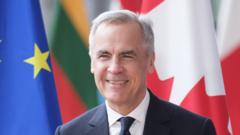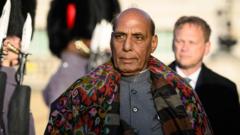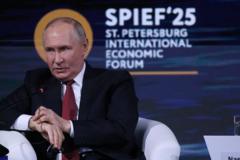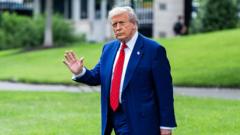As global economies confront a tariff-driven slowdown, India's protective trade policies could provide it with a temporary advantage.
**Is India's Trade Detachment a Boon Amid Global Tariff Pressures?**
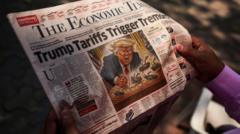
**Is India's Trade Detachment a Boon Amid Global Tariff Pressures?**
Will its inward-focused policies help India navigate the global trade slowdown successfully?
India is currently positioned as the world's fifth-largest and fastest-growing major economy. However, its historical inclination towards protectionism and inward-focused trade strategies has hindered its competitiveness on the global stage. With tariffs remaining high and global exports representing less than 2% of its economy, India's substantial domestic market has been a significant contributor to its growth, especially as the rest of the world faces economic stagnation. Interestingly, in this current era of economic challenges, India's cautious approach to trade might serve as a short-term strategic benefit.
While many countries are adjusting to new trade conditions brought on by recent US trade policy changes and a 90-day tariff hiatus announced by former president Donald Trump, India's limited involvement in global trade could insulate it from severe economic shocks. Rajeswari Sengupta, an economist at the Indira Gandhi Institute of Development Research in Mumbai, suggests that India's lower reliance on exports might position it favorably. If export-driven nations falter under the pressure of tariffs while India continues to grow at approximately 6%, it will stand in stark contrast, fortified by its vast domestic market.
Sengupta warns, however, that India must avoid complacency. To capitalize on new trade opportunities, the nation should gradually and strategically embrace more openness in trade. Achieving this goal will be challenging, especially considering India's long-standing issue with high trade barriers.
Historically, India’s trade policies have oscillated, with high protection levels shielded by strict import controls even during crises. In his book "India's Trade Policy: The 1990s and Beyond," economist Arvind Panagariya elaborates on India's journey from a protectionist regime following World War II, which stifled competitive growth, to liberalizing its economy in 1991 during a balance-of-payments crisis. This shift precipitated an exponential rise in exports, but the reverse trend has emerged since 2018, with renewed protectionism leading to a lack of competitiveness and stunted growth in key sectors.
Vivek Dehejia, an economics professor, highlights the enduring suspicion some policymakers have about international trade, viewing it as a neo-colonial threat rather than an opportunity. Furthermore, the ambitious "Make in India" initiative led by Prime Minister Narendra Modi has faced hurdles due to a decade-long retraction of liberal trade policies, particularly impacting labor-intensive industries, which are crucial for rapid export growth.
As the US fosters protectionism and China faces its scrutiny, European Union countries are actively seeking dependable trade partners, presenting an opportunity for India. Economists assert that to harness this opportunity, India needs to reduce tariffs, enhance export quality, and robustly signal its readiness for global trade integration. There is particular potential in sectors like garments and toys, which could significantly benefit small- and medium-sized businesses. However, the pressing question remains whether these industries can scale up effectively and find government support.
If former president Trump's tariff strategies resume, estimates predict a potential 6.4% decline in India's exports to the US this year. This emphasizes the necessity for India to diversify its trade agreements and reinforce partnerships with Europe, the UK, and Canada, while also fostering ties with Asian economies. Domestically, real progress will depend on implementing reforms, including simplifying tariffs and streamlining trade processes. Without these advancements, India risks remaining sidelined in the international trade arena.
While many countries are adjusting to new trade conditions brought on by recent US trade policy changes and a 90-day tariff hiatus announced by former president Donald Trump, India's limited involvement in global trade could insulate it from severe economic shocks. Rajeswari Sengupta, an economist at the Indira Gandhi Institute of Development Research in Mumbai, suggests that India's lower reliance on exports might position it favorably. If export-driven nations falter under the pressure of tariffs while India continues to grow at approximately 6%, it will stand in stark contrast, fortified by its vast domestic market.
Sengupta warns, however, that India must avoid complacency. To capitalize on new trade opportunities, the nation should gradually and strategically embrace more openness in trade. Achieving this goal will be challenging, especially considering India's long-standing issue with high trade barriers.
Historically, India’s trade policies have oscillated, with high protection levels shielded by strict import controls even during crises. In his book "India's Trade Policy: The 1990s and Beyond," economist Arvind Panagariya elaborates on India's journey from a protectionist regime following World War II, which stifled competitive growth, to liberalizing its economy in 1991 during a balance-of-payments crisis. This shift precipitated an exponential rise in exports, but the reverse trend has emerged since 2018, with renewed protectionism leading to a lack of competitiveness and stunted growth in key sectors.
Vivek Dehejia, an economics professor, highlights the enduring suspicion some policymakers have about international trade, viewing it as a neo-colonial threat rather than an opportunity. Furthermore, the ambitious "Make in India" initiative led by Prime Minister Narendra Modi has faced hurdles due to a decade-long retraction of liberal trade policies, particularly impacting labor-intensive industries, which are crucial for rapid export growth.
As the US fosters protectionism and China faces its scrutiny, European Union countries are actively seeking dependable trade partners, presenting an opportunity for India. Economists assert that to harness this opportunity, India needs to reduce tariffs, enhance export quality, and robustly signal its readiness for global trade integration. There is particular potential in sectors like garments and toys, which could significantly benefit small- and medium-sized businesses. However, the pressing question remains whether these industries can scale up effectively and find government support.
If former president Trump's tariff strategies resume, estimates predict a potential 6.4% decline in India's exports to the US this year. This emphasizes the necessity for India to diversify its trade agreements and reinforce partnerships with Europe, the UK, and Canada, while also fostering ties with Asian economies. Domestically, real progress will depend on implementing reforms, including simplifying tariffs and streamlining trade processes. Without these advancements, India risks remaining sidelined in the international trade arena.


